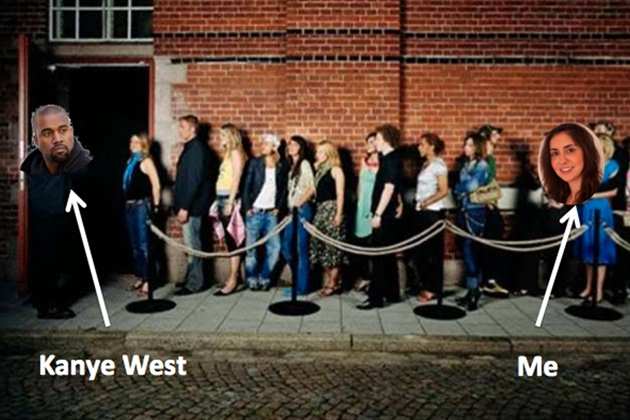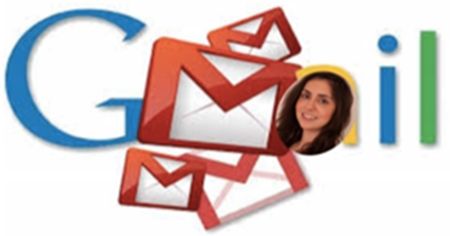Email deliverability is a hot topic.
Although countless articles have already been written about this subject, marketers are still looking for a way to crack Gmail's (and other email service providers') algorithm in an effort to guarantee their ticket into the inbox.
I'm here to explain how deliverability really works, so that you can reach the inbox without resorting to tricks that could actually hurt your reputation!
Let's talk about how you can send emails that reach the all-important inbox.
The core principles behind email deliverability are based on human-behavior patterns.
Start by imagining that I am trying to get added to Kanye's VIP list for the hottest club in LA. I'm actually standing in line, hoping that he'll let me in.

Sending email is similar! When I send a marketing email to Ms. Smith, I'm hoping that Gmail will allow me into her inbox.

Will I get in?
Just as Kanye has different levels of connection to the people waiting in line, Mrs. Smith also has unique relationships with the people and companies sending her email. Let's examine some examples. By the time we're done, you'll have a better understanding of how deliverability works.
Example 1: Pretend Kanye and I go way back. We've known each other for a long time.
If I'm Kanye's best friend, that history really means something. When I talk, he answers, and we do things together often. In fact, he asked me to come out tonight, so you can bet I'm getting in when I show up!
In the same way, email from Mrs. Smith's favorite e-commerce website will definitely reach her inbox. She gets excited when she sees those messages, always opens them, and often clicks,, too.
However, If I'm the person Kanye has been fighting with on Twitter, it's safe to assume I'm not getting in tonight.
That's just like being the email sender who becomes Mrs. Smith's worst nightmare. She bought something from him five years ago. Now, she's starting to receive his newsletter every week, even though she never subscribed. She's going to stop opening them; she'll be deleting them and maybe even marking them as spam.
The lesson? Having a shared history doesn't mean that you have a relationship. If you're not invited, don't break your way into the party. Service providers, such as Gmail, notice inbox behaviors that indicate emails are unwanted, even when the recipient isn't marking your email as spam.
Example 2: Imagine Amalia isn't my name. Surprise! I'm actually very famous.
The blessing, and curse, of being famous is that your reputation precedes you.
If I'm Michelle Obama, my reputation is pretty strong, and there's a good chance you know how much people enjoy being around me. Even if you don't know me, you'll probably let me into the party because I'm smart, witty, and even Jimmy Fallon likes to dance with me!
But let's say I'm criminal mastermind Al Capone. Everyone around the world knows who I am, what I've done, and the harm I've caused. I (or my ghost) definitely won't be getting into the party any time soon. (At least we hope not!)
The lesson? Your previous actions have a current impact on how you're treated by inbox guardians and how your emails will be delivered. Your past actions affect your deliverability both when you email to contacts who know you and when you send to new recipients.
Example 3: Thankfully, now I am my true self. I'm Amalia, and there is a small chance that you know me personally.
If Kanye thinks he might know me, he would ask me questions like...
- "Are you a friend of a friend?"
- "Where are you from?"
- "Are you coming alone or with a group?"
Similarly, Gmail asks questions such as...
- "Which IP address is sending your email?"
- "Are you on a blacklist?"
- "What is your email's content?"
If I'm lucky (and they like my answers to their questions), both Kanye and Gmail will let me in!
The lesson? Deliverability is affected by many factors. Make quality your goal anytime there is a decision to be made about your email program. Using a quality email service provider, sending to quality (engaged, opt-in) contacts, and providing quality content are all solid investments in reaching the inbox.
What happens next time? Everything comes back to your reputation...
For the sake of our example (and my ego), let's assume that I got into the party. Yay!
The next time Kanye has a party (or I'm sending a new email to Mrs. Smith), will I get in?
It all depends on how it went the first time. Kanye would wonder how well I did at the last party. And Gmail would ask how well Mrs. Smith responded to my previous email. Did she open it? Click my call to action? And above all, did she not click on "Report as spam"?
This concept is is referred to as "sending reputation." And your reputation is the key to getting delivered in the inbox.
How do you build a positive reputation?
Positive sending reputations are built by sending campaigns that engage recipients. Consider these metrics to benchmark your campaigns:
- Open rate: Are at least 20% of your recipients (depending on your list size) opening your emails?
- CTR (click-through rate): Are recipients clicking on your call-to-action?
- Complaints: Are very, very few people clicking on "Report as spam"?
- Hard bounces: Are very few email addresses invalid or closed accounts?
If you can answer, "yes" to those questions, that's a great sign that your recipients are happy to receive your emails and that your contact database is up-to-date.




